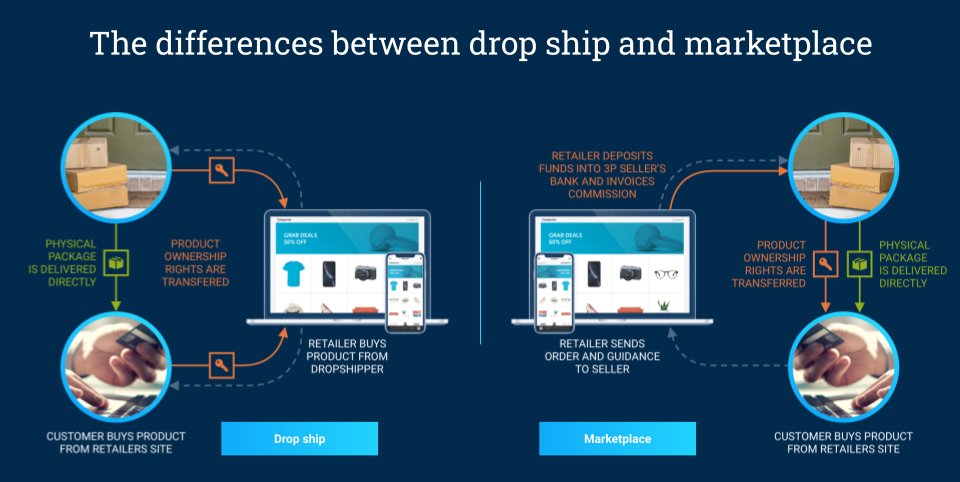There are different business models to consider, but how do you determine which one is suitable for your needs?
Let’s say you’re involved in the world of e-commerce and want to expand your product range. How do you approach it? The simple answer is to choose between dropshipping or a marketplace. But is the choice really that straightforward? What are the differences or similarities between these options? And how can your company make the best decision? These questions may arise, but fortunately, we have answers.
Both dropshipping and marketplaces enable retailers to sell products to their customers. However, the difference lies in the objective. Dropshipping is suitable for companies that want full control over the customer experience and wish to curate a composed product assortment. Additionally, with dropshipping, you are ultimately responsible for handling warranty issues and customer inquiries.
On the other hand, marketplaces are intended for businesses that want to offer the widest possible product range without having to do all the work themselves. By leveraging sellers on your own marketplace, tasks such as creating product content and handling inquiries and warranty issues are outsourced to the sellers. These are significant differences. Let’s outline the key advantages and characteristics of both marketplaces and dropshipping so that you can make the best choice for your business.
What is dropshipping and how does it work?
Dropshipping is a method of order fulfillment where the retailer doesn’t hold inventory in their own warehouse. Instead, the retailer purchases the product from a vendor who then directly ships it to the customer. The “inventory risk” is shifted from the retailer to the vendor. The retailer never physically handles the products. This allows a retailer to quickly expand their product range and test offerings.
However, this doesn’t mean that the retailer has nothing to do. They are still responsible for aspects like pricing, returns, promotions, and customer service. Retailers often have to manage content themselves, creating a potential bottleneck due to employee capacity. Ultimately, customers want to receive what they purchased as quickly as possible. Dropshipping is commonly used in product categories where the cost of inventory management needs to be reduced, such as large items like furniture where transportation can be expensive.
Benefits of Dropshipping:
- Inventory risk reduction: You reduce the risks associated with holding inventory, optimizing cash flow and saving on inventory management costs. This makes your business more profitable.
- Brand control: The vendor remains invisible to the end customer, allowing the retailer to fully manage merchandising and promotions.
- Price and margin control: The retailer determines the final selling price and controls the margin, ensuring alignment with their own inventory and desired price perception.
- Returns and customer service: The retailer remains responsible for first-line support for service calls and returns.
Now, let’s discuss marketplaces and how they work.
On an online marketplace, external sellers can sell products directly to end customers through a retailer’s existing e-commerce platform. In other words, the supplier and the buyer enter into a direct agreement, and the retailer simply ensures the smooth process. In this case, the supplier becomes the seller, determining the selling price and handling customer service. Compared to dropshipping, a marketplace is much more efficient for a retailer.
Are marketplaces more scalable than dropshipping? Absolutely, because the retailer can delegate a significant portion of onboarding, catalog management, and customer service to their network of external vendors. The transparency of marketplaces and the competition among sellers enable customers to enjoy favorable prices and a wide range of products.
Benefits of the Marketplace Model:
- Increased revenue: Offering a broader assortment engages customers and sellers more, and enhances operational efficiency.
- Greater speed: Quickly introduce categories with efficient vendor onboarding, faster catalog integration, and seamless inventory updates.
- Greater scale: Expand your product range and increase operational capacity by shifting more responsibilities to external sellers.
- Improved flexibility: Adapt your assortment and prices to meet your customers’ needs.
Both dropshipping and marketplaces have their advantages and considerations. Choosing the right model depends on your specific business goals, capabilities, and the desired level of control over the customer experience and product assortment.
Dropshipment or Marketplace?
That sounds great, but what if you don’t want to choose at all? After all, both dropshipping and marketplaces provide an expansion of your product range and an increase in revenue. Well, with Mirakl, you don’t have to choose and can combine the best of both worlds on a single platform. You can make the choice between dropshipping and a marketplace for each vendor individually.
So, what is the best choice? Well, it really depends on where your company wants to go and what your needs are. Our experienced specialists are more than happy to advise you on the advantages and disadvantages of both business models. Feel free to contact us for an introduction!
